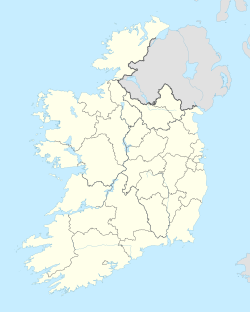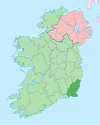world.wikisort.org - Ireland
Bunclody (Irish: Bun Clóidí, meaning 'bottom of the (river) Clody'), formerly Newtownbarry (until 1950), is a small town on the River Slaney in Wexford, Ireland. It is located near the foot of Mount Leinster. Most of the town is in County Wexford; a small area at the north end of town is in County Carlow. Bunclody has received a number of high scores in the Tidy Towns competition. The town is known for the "Streams of Bunclody Festival" held during the month of July.[citation needed]
Bunclody
Bun Clóidí | |
|---|---|
Town | |
 Bunclody's market square | |
 Bunclody Location in Ireland | |
| Coordinates: 52.655°N 6.651°W | |
| Country | Ireland |
| Province | Leinster |
| County | Wexford |
| Elevation | 52 m (171 ft) |
| Population (2016)[1] | 1,984 |
| Irish Grid Reference | S909569 |

The R746 regional road intersects the N80 in the middle of Bunclody.
| Year | Pop. | ±% |
|---|---|---|
| 1821 | 1,095 | — |
| 1831 | 1,430 | +30.6% |
| 1841 | 1,437 | +0.5% |
| 1851 | 1,307 | −9.0% |
| 1861 | 1,097 | −16.1% |
| 1871 | 1,014 | −7.6% |
| 1881 | 960 | −5.3% |
| 1891 | 909 | −5.3% |
| 1901 | 890 | −2.1% |
| 1911 | 884 | −0.7% |
| 1926 | 709 | −19.8% |
| 1936 | 684 | −3.5% |
| 1946 | 699 | +2.2% |
| 1951 | 805 | +15.2% |
| 1956 | 976 | +21.2% |
| 1961 | 891 | −8.7% |
| 1966 | 940 | +5.5% |
| 1971 | 929 | −1.2% |
| 1981 | 1,467 | +57.9% |
| 1986 | 1,423 | −3.0% |
| 1991 | 1,316 | −7.5% |
| 1996 | 1,241 | −5.7% |
| 2002 | 1,361 | +9.7% |
| 2006 | 1,863 | +36.9% |
| 2011 | 2,012 | +8.0% |
| 2016 | 1,984 | −1.4% |
| [2] | ||
Name
During the 17th century, the name of the town was changed from Bunclody to Newtownbarry, but was reverted to its original name in the 20th century, following Irish independence. The change was made official by a local government order in 1950.[3]
History

Although a hamlet already existed here, Bunclody was raised to the status of a post town in 1577 by alderman James Barry, sheriff of Dublin.[4][5]
The town was the scene of the Battle of Bunclody during the 1798 rebellion.[6]
In the 19th century, a small canal was made, drawing water from the Clody river, to provide drinking water for the town.[7] The canal still flows along the middle of the town's main street. During the Tithe War, 1830–1836, 'Newtownbarry' was the scene of a clash between locals and the officials of the Crown. Locals had become enraged by the seizure of property by the police and army to pay for the Protestant Episcopal polity. According to James Connolly, "twelve peasants were shot and twenty fatally wounded".[8]
In 1884, a metal bridge was built across the River Slaney upstream from today's bridge. It was built of iron from New Ross, and assembled in the bridge meadow beside where the bridge stood. This bridge was washed away in 1965 by a flood. The remains of the bridge were visible from the bank of the river for some years, until it was removed in 2007, during the building of Bunclody Golf and Fishing Club beside the River Slaney.[citation needed]
Among the amenities of the town there are number of GAA and soccer pitches, an outdoor swimming pool (open 2½ months of the year), an aparta-hotel, and two primary and two post-primary schools and an Adult Education & Training Centre.[citation needed]
Notable residents included the travel writer Mabel Hall-Dare (1847-1929), who grew up in the town before her marriage, in 1877, to the explorer J. Theodore Bent (1852-1897).[9] At nearby Ballyrankin House lived the mother and daughter writers Moira O'Neill (1864–1955) and Molly Keane (1904–1996).[10]
Civil War events
The town was a site of three fatalities during the Irish Civil War.
The first was James Roche, a member of the Anti-Treaty IRA, who died in a car crash on 4 July 1922.[11]
The second person killed was Lieutenant Ignatius "Nacey" Redmond, a local member of Sinn Féin, who held the post of secretary. He had overseen pro-treaty meetings in Easter 1922 in the town, in opposition to the position of his comrades, and resigned his post in Sinn Féin in August 1922 before joining the pro-treaty Free State army. On 2 October 1922, he was killed approximately two and a half miles from Bunclody on the old Bunclody-Kiltealy road.[12][13]
The third was 29 year old Thomas Doyle, a World War I veteran from Enniscorthy, who later worked as a clerical officer with the Free State army. He was shot dead at Ryland's Cross outside the town when a Free State army vehicle was ambushed on 1 December 1922.[14]
Demography
Bunclody-Carrickduff is a census town split between County Carlow and County Wexford. It comprises the town of Bunclody and the adjoining village of Carrigduff, and had a population of 1,984 at the 2016 census.[1] An increase from 1,863 as of the 2006 census.[15]
Demographically, a number of nationalities are represented, with approximately 13% of its population being Polish,[16] and approximately 11% Irish Traveller.[17]
Schools
The town has two primary schools: Bunclody National School and Carrigduff National School. There are two secondary schools. The FCJ Secondary School and Bunclody Vocational College. The FCJ (Faithful Companions of Jesus) school was founded by a French order of nuns in 1861, and was a boarding school for girls throughout the 20th century.[citation needed] The all-girls school provided education for day pupils and accepted male day pupils from the late 1960s when the school became co-educational. The old boarding school was demolished in 2002.[citation needed]
Tourism and culture
Bunclody featured in the 2018 Venice Architectural Biennale, alongside 9 other Irish market towns.[citation needed] A volunteer led tourist office is open in the town.[citation needed]
There is an "Urban Adventure Hub" (managed by WWETB Slielbaggan Outdoor Activity Centre) at Ryland Road which allows access to water sports on the River Slaney.[citation needed] There are also a number of walking trails along the Clodey Valley and off-road trails at Coolmeelagh and Kilbranish. It is also a point on the Columban Way, which runs from Bangor, County Down through Bunclody and on through mainland Europe to Bobio in Italy – following the life journey of Saint Columbanus.[18]
A folk song about Bunclody, titled Streams of Bunclody and written by a local emigrant,[19] was reputedly one of Luke Kelly's "favourite ballads".[20]
Transport
The town is approximately 25 km from the M9 motorway and 20 km from the M11.[citation needed] Bunclody is served by Local Link bus routes 368 (Bunclody to Enniscorthy) and 369 (New Ross to Tullow via Bunclody).[21] Wexford Bus also provides a scheduled service from Wexford to Carlow via Bunclody on route 376.[22] 'Ring a Link' buses also serve Bunclody linking it to Carlow.[23] On Thursdays Bunclody is served by Bus Éireann's cross-country service from Rosslare Europort to Dublin via Carnew.[citation needed]
While Bunclody was never served by rail, early 19th century proposals called for two railway lines to serve the area; These plans never progressed.[24] The nearest station is Enniscorthy railway station approximately 23 kilometres away.
Sport
Bunclody Golf and Fishing Club was officially opened in early 2009. The course is on the Carlow side of the town. The 18 hole course is set on 300 acres (1.2 km2) beside the river Slaney, and is home to Ireland's first on-course elevator, which links the 17th green to the 18th tee. The great spotted woodpecker, Ireland's newest breeding bird, was spotted there in 2013.[25] Bunclody Golf and Fishing Club hosted the Irish PGA in August 2019.[26]
References
- "Sapmap Area - Settlements - Bunclody-Carrickduff". Census 2016. Central Statistics Office Ireland. April 2016. Retrieved 26 December 2019.
- www.cso.ie/census and www.histpop.org Archived 2016-05-07 at the Wayback Machine. Figures post 1951 are for Bunclody-Carrigduff, a conurbation that straddles the Wexford-Carlow borders. For a discussion on the accuracy of pre-famine census returns see JJ Lee "On the accuracy of the pre-famine Irish censuses" in Irish Population, Economy and Society edited by JM Goldstrom and LA Clarkson (1981) p54, and also "New Developments in Irish Population History, 1700-1850" by Joel Mokyr and Cormac Ó Gráda in The Economic History Review, New Series, Vol. 37, No. 4 (November 1984), pp. 473–488.
- "S.I. No. 281/1950 — Local Government (Change of Name of Non-Municipal Town) Order, 1950". irishstatutebook.ie. 1950.
- Hayward, Richard (1949). Leinster and the City of Dublin. Barker. p. 108.
- Brewer, J. N. (1825). The Beauties of Ireland: Being Original Delineations, Topographical, Historical, and Biographical, of Each County. Sherwood: Jones, & Co. p. 378.
- DeVal, Seamus. "A History of Bunclody, Wexford, Ireland".
- Bassett, George Henry (1991). Wexford County Guide and Directory. Hibernian Imprints. pp. 343–347. ISBN 1-874238-00-6.(original publication 1885)
- "Labour In Irish History". marxists.org. Retrieved 16 August 2021.
- "Obituaries: Nature 124, 1929". The Times. 4 July 1929. p. 65.
- "Burning of Ballyrankin House by IRA may have been an act of reprisal". New Ross Standard. Independent News & Media. 20 March 2021.
- "Fatalities". Brigade Activity. Retrieved 30 October 2022.
- "Lieutenant Ignatius Redmond". www.bunclody.net. Retrieved 3 October 2022.
- "Fatalities". Brigade Activity. Retrieved 30 October 2022.
- "Fatalities". Brigade Activity. Retrieved 30 October 2022.
- "CSO Census 2006: Table 5, Population of Towns ordered by County and size, 2002 and 2006" (PDF). cso.ie.
- "CENSUS 2016 -NON-IRISH NATIONALITIES LIVING IN IRELAND / POLISH". Central Statistics Office, Dublin.
- "Theme 2 - 3 : Usually resident population by ethnic or cultural background, 2006". beyond2020.cso.ie. Central Statistics Office, Dublin. Archived from the original on 25 July 2011.
- "The Columban Way". thecolumbanway.eu. Archived from the original on 25 December 2018.[failed verification]
- "RTÉ Archives - Singing Folk Trio Emmet Spiceland - 1968". rte.ie. Retrieved 16 August 2021.
'By the Streams of Bunclody' is said to have been written by a homesick Wexford emigrant
- "FBI agent sings about Bunclody". Enniscorthy Guardian. 1 September 2000.
It has often been reported that the late Luke Kelly of the Dubliners included `Streams of Bunclody' among his favourite ballads
- "Timetables". locallinkwexford.ie.
- "Route 376 March 2017" (PDF). wexfordbus.com. Archived from the original (PDF) on 15 November 2017. Retrieved 30 June 2019.
- "Ringalink.ie". Archived from the original on 17 February 2015. Retrieved 18 May 2015.[failed verification]
- "Railways and County Carlow". rootsweb.ancestry.com. Archived from the original on 6 March 2016.[better source needed]
- "Great Spotted Woodpecker (Dendrocopos major) - Irish Birding". www.irishbirding.com. Retrieved 5 April 2018.
- "RTÉ Sport - McGrane secures Irish PGA Championship in Bunclody". rte.ie. 22 August 2019.
External links
На других языках
[de] Bunclody
Bunclody (irisch Bun Clóidí, dt.: „Tal(sohle), Ende des Clody“),[2] ist eine Stadt auf der Grenze der Countys Carlow und Wexford im Südosten der Republik Irland.[3]- [en] Bunclody
[ru] Банклоди
Банклоди[2] (англ. Bunclody, также Bunclody-Carrickduff; ирл. Bun Clóidí-Carraig Dhubh, «дно Клоди») — (переписной) посёлок в Ирландии, находится на границах графств Уэксфорд (провинция Ленстер) и Карлоу. Наиболее известен фестивалем Eileen Aroon, проходящем здесь в июле-августе[3].Другой контент может иметь иную лицензию. Перед использованием материалов сайта WikiSort.org внимательно изучите правила лицензирования конкретных элементов наполнения сайта.
WikiSort.org - проект по пересортировке и дополнению контента Википедии
